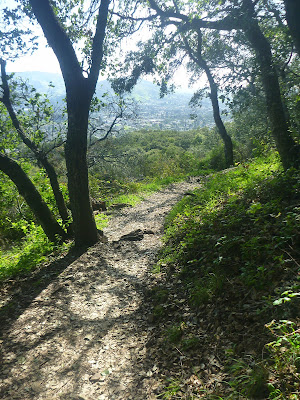 |
| Garden and trail directions in the San Luis Obispo Botanical Garden |
The San Luis Obispo Botanical Garden (SLOBG) features a Fire Safe Garden, a Display Garden and the Discovery Trail. The latter loops up and down across open-space hills. According to the posted San Luis Obispo Botanical Garden map at the visitor center, there are ambitious plans for a Future Garden.
The Future Garden will include a moderate, three-mile-long loop trail: the Panorama Trail connecting five separate areas dedicated to specific biogeographic zones—the mediterranean climate regions. Each area will have an interpretive kiosks, focussing on plants native to one of the regions: the Mediterranean Basin and coastal regions in California, Chile, South Africa, and Australia.
Currently, the Display Garden features plants from the Mediterranean ecoregions. Here, I am presenting snapshots from a garden tour starting at the Fire Safety Garden, continuing through the Display Garden and then exploring the rolling hills by taking you along my loop hike following the Discovery Trail.
Fire Safe Garden
To the right of the visitor center is the Fire Safe Garden, which contains panels with information on how to improve the fire safety of your home by implementing fuel reduction and avoiding highly flammable structures and building materials.Keep fire-resistant and “water-smart” plants in mind while designing the garden around your house. Although all plants can burn, here are some characteristics you want to look at while selecting plants. Prioritize those that
- store water in their stems and leaves (like succulents),
- hold moisture with little extra watering,
- grow deep roots to obtain water and limit erosion,
- produce little dead material and litter,
- grow low, slow, and need little care,
- grow open and loose with little total vegetation,
- contain very little volatile resins or oils.
Display Garden
The Display Garden neighbors the Fire Safe Garden. During my visit in early March of 2024, the well-known evergreen of California, the Monterey Cypress (Cupressus macrocarpa), and two Aloe species (A. speciosa and A. nobilis) from South Africa, caught my attention.
 |
| Monterey Cypress (California), Cupressaceae |
 |
| Aloe speciosa (South Africa), Liliaceae |
 |
| Aloe nobilis (South Africa), Liliaceae |
The common name for Aloe nobilis is Golden Toothed Aloe and you immediately see why.
Discovery Trail
The Discovery Trail begins in the Fire Safe Garden, from where it winds uphill to the sundial. This is an interactive sundial: Once you step into the dial onto the month of the day of your visit and put your hands together over your head, your shadow points to the hour. The picture suggests that I was there around 4:30 pm. Since the sundial is based on daylight savings and I was there at 3:30 pm a day before the start of daylight saving time, I appreciate how well this sundials tells the time (at least, for the purpose of leisure hiking).
 |
| Sundial |
Next to the sundial is a grove of Chilean wine palms (Jubaea chilensis). Since palms of this species produce nuts that taste like coconuts, the name “Chile cocopalm” is also used. A SLOBG panel describes how the (relatively) young palms ended up here:
 |
| Chilean wine palm |
Native to Chile, these palms came from seeds from trees at a motel in King City, California, and a church in Arroyo Grande.
Now 12 to 16 years old, they can live well over one hundred years and reach 80 ft high with trunks 4 to 6 feet in diameter.
At 40 years old, they produce flowers, edible fruit, and nuts. The nuts taste like coconuts.
These Chilean wine palms (Jubaea chilensis), used to be cut down to harvest their sap for a wine-like liquor. They are now protected here and in La Campana National Park, Chile.
 |
| Lizard on lichen |
Near the junction of the Eagle Rock Trail with the Discovery Trail, I gave myself some time at the panel with the title “Where are the volcanoes?” (subtitle: “Where did these peaks come from?”) to find out about The Morros:
The Morros are a string of some twenty ancient volcanic plugs. They stretch 16 miles from near San Luis Obispo Airport to the ocean. These plugs were all formed about 20 to 25 million years ago and have been inactive since then.
For over 100 million years, the North American continent had been drifting westward over Pacific sea floor, forcing rocks downward along its western edge where they melted back into the earth's mantle. This formed a jumbled mix of geologic debris known as the Franciscan Formation, which surrounds these volcanic plugs.
About 20 to 25 million years ago, the North American continent bumped into an ocean ridge. This formed huge pressures which melted rocks into magma and forced the magma to the surface. The magma may have followed existing fault lines or slabs of old rock and oozed (like toothpaste) to the surface as a line of volcanoes.
The peaks you see today are what remains of the ancient plugs of magma formed within these volcanoes. The Franciscan Formation surrounding these volcanoes was made of older and softer rocks that crumbled and were washed away. As the Franciscan wore away, weather and landslides broke up the sides of the exposed plugs into what remains today.
Just a day before I came here, I climbed, via the Summit Trail, to the top of Bishop Peak—the highest of the Morros. Another Morro, Cerro Romauldo, can be seen from various sections of the Discovery Trail.
 |
| Cerro Romauldo with Eagle Rock on the left |
I am finishing the botanical garden tour with the wavy-leafed soap plant (Chlorogalum pomeridianum), featured alongside the northwest section of the Discovery Trail. This interesting plant that was of value to local Chumash and Salinan people, who used the crushed bulb to wash their hair and clothes and fabricated hair brushes from the bulb's tough fibers.
 |
| Wavy-edged leaves of the wavy-leafed soap plant |
Today, the wavy-leafed soap plant—and the habitat is it is found in—is of value to all of us. It inspired us learn more about its cultural history as well as its biochemistry.
Getting there
The San Luis Obispo Botanical Garden is located in the El Chorro Regional Park on scenic Highway 1 between San Luis Obispo and Morro Bay, California.
Address: 3450 Dairy Creek Road, San Luis Obispo, CA 93405.
 |
| Visitor Center |
Backup and interesting reading
Master Plan for the San Luis Obispo Botanical Garden. PDF: https://static1.squarespace.com/static/59f8d9d8e45a7c6679c6394a/t/5bbe3a4eeef1a1188bc9bad0/1539193507157/SLOBG+Master+Plan.pdf.
Pam and Gary Baker. Exploring the San Luis Obispo Botanical Garden. Garden Destinations. URL: https://www.gardendestinations.com/exploring-the-san-luis-obispo-botanical-garden/.
D. Spano, R. L. Snyder and C. Cesaraccio (2003). Mediterranean Climates. In: Schwartz, M.D. (eds) Phenology: An Integrative Environmental Science. Tasks for Vegetarian Science, vol 39. Springer, Dordrecht. DOI:10.1007/978-94-007-0632-3_10.
Rhys Heyden. Peaks that pique: A guide to hiking and exploring SLO County's Nine Sisters. New Times, January 21, 2015.URL: https://www.newtimesslo.com/news/peaks-that-pique-a-guide-to-hiking-and-exploring-slo-countys-nine-sisters-2947800.
David Chipping. Plant Associations and the Geology of the Morros. CNPS-SLO. URL: https://cnpsslo.org/2018/05/plant-associations-and-the-geology-of-the-morros/.
Wavy-leafed Soap Plant. iNaturalist. URL: https://www.inaturalist.org/guide_taxa/181613.










